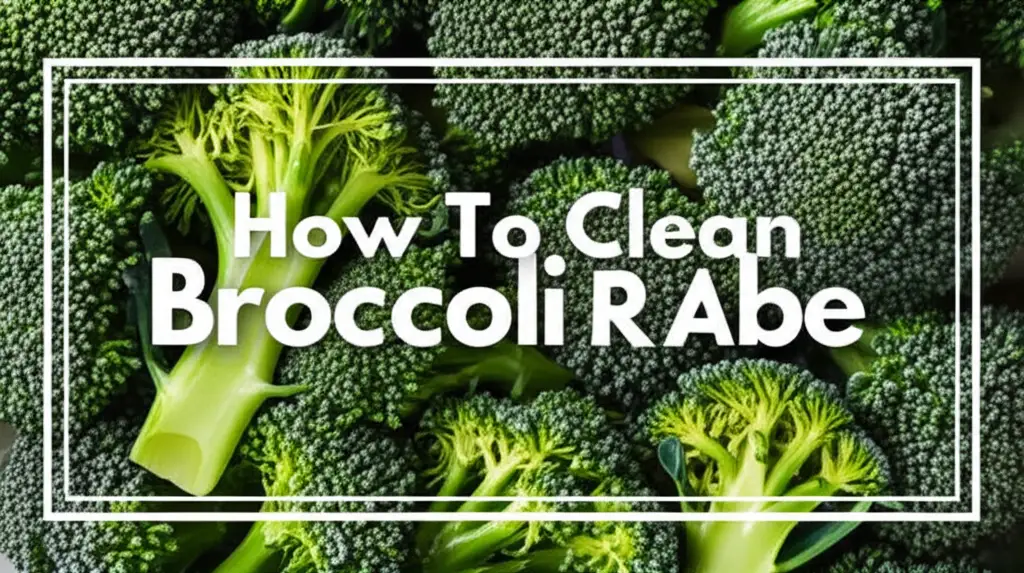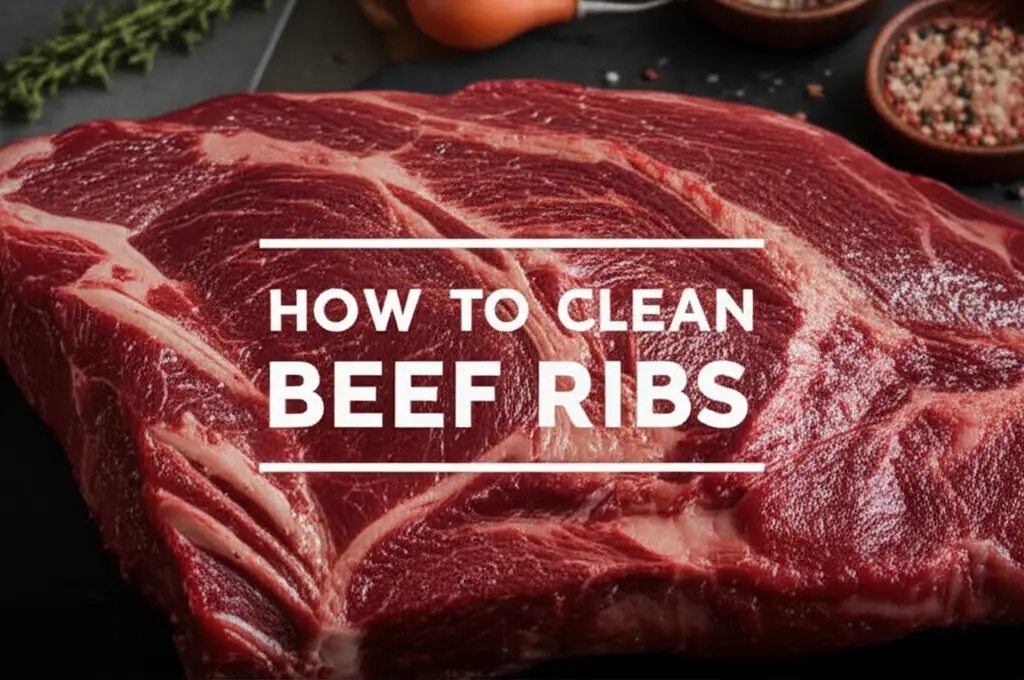· Food Preparation · 16 min read
How To Clean Broccoli Rabe

Clean Broccoli Rabe for Best Flavor and Safety
Cleaning broccoli rabe helps you prepare tasty meals. It makes sure your food is safe to eat. This guide shows you simple steps to wash this green vegetable. We will cover how to remove dirt and how to make it taste less bitter. You will learn about the right tools and methods. We help you get your broccoli rabe ready for cooking.
Sometimes, fresh vegetables carry unwanted things. Broccoli rabe is no different. It can hold dirt, sand, or small insects. Proper cleaning removes these things. It also helps with the plant’s natural bitter taste. Follow our simple instructions. Your broccoli rabe will be clean, fresh, and ready for your favorite recipes. We focus on clear steps. This makes sure you get good results every time.
Takeaway:
- Inspect broccoli rabe for dirt and damage.
- Trim tough stems before washing.
- Soak bunches in cold water to loosen grit.
- Rinse thoroughly under running water.
- Consider blanching to reduce bitterness.
- Dry well for better storage and cooking results.
To clean broccoli rabe, first inspect it for dirt and trim tough ends. Then, soak the vegetable in cold water for a few minutes. This loosens any grit. After soaking, rinse the broccoli rabe under cold running water to wash away dirt. You can also blanch it to reduce its natural bitterness before cooking.
Why Cleaning Broccoli Rabe Matters for Your Meal
Broccoli rabe offers a unique flavor to many dishes. Before you cook it, cleaning is important. This plant grows in soil. It often comes with dirt, sand, and tiny insects hidden in its leaves and florets. Eating unclean vegetables can cause health issues. Proper washing makes sure your food is safe.
Cleaning also helps with the taste. Broccoli rabe has a natural bitterness. Washing, and sometimes an extra step like blanching, helps lessen this strong taste. This makes the vegetable more pleasant for many people. It allows other flavors in your dish to shine. Ignoring this step means you might end up with a gritty or too-bitter meal.
Think about the quality of your ingredients. A clean vegetable cooks better. It also looks better on your plate. Fresh produce is a great part of healthy eating. Taking time to clean it correctly adds to its value. It ensures your meal is both delicious and safe. We want your cooking experience to be good. Starting with clean ingredients is a big part of that.
Inspecting Your Broccoli Rabe Bunch
Start by looking at your broccoli rabe. Hold a bunch and check it closely. Look for any yellowed leaves. These leaves are old or damaged. You should remove them. Also, check for wilting parts. Wilting shows the plant is not fresh. Discard these parts too.
Look deep into the florets and leaves. You might see small specks of dirt. Sometimes, tiny bugs can hide there. These bugs are not harmful if eaten, but nobody wants them in their food. This is like checking other leafy greens. You want a clear surface for cooking. For example, if you find pests like those on its cousin, you might need to give it extra attention. Knowing how to clean broccoli worms can help with similar issues on rabe.
You also need to feel the stems. Are they firm or soft? Hard, thick stems are often very bitter and woody. We will talk about trimming these later. The goal is to start with good, fresh parts. A good inspection helps you prepare the vegetable well. It saves time later in the cleaning process.
The Essential Tools for Washing Broccoli Rabe
You do not need many special tools to clean broccoli rabe. Most items are already in your kitchen. Having the right tools makes the job easier and faster. This part will list what you need. It explains why each tool is useful.
First, you need a large bowl or a clean sink basin. This will hold the broccoli rabe during soaking. A large size is important. It lets the vegetable move freely in the water. This helps dirt come off easily. Make sure your sink or bowl is very clean before you start. Cleanliness in your kitchen workspace is important when handling food.
Next, you need a colander. This tool has holes. It helps drain water away from the vegetable. A colander makes rinsing simple. It keeps the broccoli rabe from falling into the sink. Choose a colander big enough to hold your entire bunch of rabe. This avoids having to wash it in small batches.
Finally, you will need paper towels or a clean kitchen towel. These help dry the vegetable. Drying is an important step. Wet broccoli rabe does not cook well. It can also spoil faster if stored wet. A salad spinner is also a great option for drying. It removes water quickly and gently.
Water Quality and Its Role
The water you use to wash your broccoli rabe matters. You need clean, cold water. Tap water is usually fine for washing produce. If you have concerns about your tap water, use filtered water. Clean water helps remove dirt and germs. It does not add new ones.
Cold water is best for washing vegetables. It helps keep the broccoli rabe crisp. Warm water can make it wilt. Fill your large bowl or sink with cold water. Make sure there is enough water to fully cover the broccoli rabe.
Some people worry about impurities in their tap water. If your water tastes or smells strange, consider using a water filter. Filters remove many unwanted substances. They provide cleaner water for drinking and cooking. Maintaining your how to clean a water filter helps ensure this. Clean water is a basic part of safe food preparation. It helps ensure the vegetable itself stays clean after washing.
Step-by-Step Guide to Cleaning Broccoli Rabe
Cleaning broccoli rabe is a simple process. Follow these steps carefully. They ensure you remove all dirt and grit. This prepares the vegetable for cooking. We will break down each action.
First, get your workspace ready. Clear your counter. Get a large bowl or use a clean sink basin. Have your colander nearby. Make sure you have access to cold running water. This makes the process smooth.
Start by cutting the string or band that holds the broccoli rabe bunch. Separate the stems. This allows you to inspect each piece better. It also helps the water reach all parts during washing. Take your time with this first part. It sets up the rest of the cleaning.
After preparing, you will trim the stems. Then, you will soak the vegetable to loosen dirt. Finally, you will rinse it under running water. Each step is important. Skipping one can leave you with unclean broccoli rabe. We aim for a thorough clean.
Trimming the Tough Stems
Broccoli rabe stems can be very tough. The bottom part is usually woody and bitter. You need to cut this part off. Take each stalk. Feel the stem. It will get softer as you move up from the cut end. Find where the stem starts to soften. This is usually about one to two inches from the bottom.
Use a sharp knife to cut off the tough ends. You want to remove all woody parts. These parts do not taste good. They are hard to chew. Sometimes, the stems are thick all the way up. In this case, you can peel the outer layer of the stem with a vegetable peeler. This reveals the more tender inside. Peel just enough to remove the stringy outside.
Trimming makes the broccoli rabe more enjoyable. It also helps the vegetable cook evenly. The softer parts will cook faster. The woody parts would stay hard even after cooking. Proper trimming is key to a good final dish. Do this for all stalks in your bunch.
Soaking for Deep Clean
Soaking is a very important step. It helps remove hidden dirt and sand. Fill your large bowl or clean sink with cold water. Place the trimmed broccoli rabe into the water. Make sure all parts are fully submerged.
Let the broccoli rabe soak for 5 to 10 minutes. During this time, dirt and sand will sink to the bottom of the bowl. You might see the water become cloudy. This shows that the soaking is working. It pulls grime from the leaves and florets. Swish the broccoli rabe gently in the water. This helps dislodge more dirt.
Do not overcrowd the bowl. If you have a large amount, soak it in batches. This allows enough space for the dirt to separate. Soaking is a gentle way to clean. It does not damage the delicate leaves or florets. This step is more effective than just a quick rinse.
Rinsing Thoroughly
After soaking, you need to rinse the broccoli rabe very well. This removes any remaining dirt and the water used for soaking. Lift the broccoli rabe from the soaking water. Be careful not to stir up the dirt that settled at the bottom. Discard the dirty water.
Place the broccoli rabe into a colander. Rinse it under cold running water. Hold the colander under the faucet. Use your hands to move the broccoli rabe around. This ensures water reaches every leaf and floret. Continue rinsing for a few minutes. You want to see no more dirt coming off.
You can also run water directly over each stalk if you wish. This is good for very dirty bunches. Make sure the water flows freely through all parts. The goal is to wash away all grit and residue. A good rinse prepares the broccoli rabe for the next steps. It makes sure the vegetable is clean before cooking.
Removing Bitterness: An Important Step
Broccoli rabe is known for its distinct bitter taste. Some people love it. Others find it too strong. You can reduce this bitterness with a simple extra step. This step is not about cleaning dirt. It is about improving the flavor. There are a few ways to do this.
Reducing bitterness makes the vegetable more appealing. It allows its earthy notes to come through more clearly. This is especially helpful if you are new to cooking with broccoli rabe. It also helps if you are serving it to people who do not like bitter flavors. This step is optional. If you enjoy the strong bitter taste, you can skip it.
However, if you want a milder flavor, follow one of the methods below. These techniques work by drawing out some of the bitter compounds. They make the broccoli rabe more versatile for different recipes. Try them out to find your preference.
Blanching Method
Blanching is a popular way to reduce bitterness. It involves quick cooking in boiling water. First, bring a large pot of water to a rolling boil. Add a good pinch of salt to the water. This helps season the vegetable. It also helps preserve its green color.
Once the water boils, carefully add the cleaned broccoli rabe. Cook it for 1 to 2 minutes. Do not cook it for too long. You want it to still be bright green and crisp-tender. Overcooking makes it mushy.
After blanching, use tongs or a slotted spoon to remove the broccoli rabe. Immediately plunge it into a bowl of ice water. This is called an ice bath. The ice bath stops the cooking process. It locks in the bright green color. Let it sit in the ice bath for 1-2 minutes. Then, remove it and drain well. This method effectively reduces bitterness. It also makes the broccoli rabe slightly more tender.
Salting Technique
The salting technique is another way to lessen bitterness. This method uses salt to draw out bitter juices. It is simpler than blanching. You do not need a pot of boiling water.
Take your cleaned and trimmed broccoli rabe. Place it in a large colander or on a clean cutting board. Sprinkle a generous amount of salt over the entire bunch. Use about 1 tablespoon of coarse salt per pound of broccoli rabe.
Toss the broccoli rabe gently to distribute the salt. Let it sit for 15 to 30 minutes. During this time, you will see moisture start to collect at the bottom. This liquid contains some of the bitter compounds. After waiting, rinse the broccoli rabe very well under cold running water. This removes all the excess salt. Make sure no salt remains. Then, dry it thoroughly. This method is effective and easy. It makes the vegetable milder in taste.
Drying Broccoli Rabe Properly
After cleaning and optionally blanching or salting, drying your broccoli rabe is essential. This step is often overlooked. But it plays a big role in how your vegetable cooks. It also affects how long it stays fresh in storage.
Wet broccoli rabe does not cook well. If you try to sauté it while it is wet, it will steam instead of brown. This can lead to a soggy texture. Dry broccoli rabe gets a better sear. It cooks more evenly. This helps improve the final flavor and texture of your dish.
Drying also helps with storage. Moisture is the enemy of fresh produce. Any remaining water on the leaves can speed up spoilage. It can cause mold or wilting. Taking time to dry it properly keeps your broccoli rabe fresh longer. This means less waste. It helps you enjoy your produce for more days.
Spin Dryers vs. Towels
You have two main choices for drying broccoli rabe. Both work well. The best choice depends on what tools you have.
A salad spinner is the fastest and most efficient way. Place the washed broccoli rabe in the spinner basket. Do not overfill it. Close the lid. Spin it quickly for 30 seconds to a minute. The centrifugal force throws water off the leaves. You will see water collect in the outer bowl. Repeat spinning if needed. Salad spinners are great for removing a lot of water quickly. They are gentle on the leaves.
If you do not have a salad spinner, use clean paper towels or a kitchen towel. Lay a few layers of paper towels on a clean counter. Spread the broccoli rabe in a single layer on top. Place more paper towels or another clean towel over the top. Gently pat and press the broccoli rabe. This absorbs the water. You may need to replace the wet towels with dry ones. Repeat until the broccoli rabe feels dry to the touch. This method takes more time. It is just as effective as a spinner.
Storing Cleaned Broccoli Rabe
Once your broccoli rabe is clean and dry, proper storage is important. This helps keep it fresh for longer. It protects your hard work. Storing it correctly prevents waste. You can enjoy your vegetable for several days.
Fresh broccoli rabe tastes best when cooked soon after buying. But if you have cleaned a large batch, you will want to store some. The key to good storage is keeping it dry and cool. Moisture is what causes fresh greens to spoil fast. It can lead to wilting and mold.
Do not store broccoli rabe in a sealed container if it is still wet. This traps moisture. It creates a bad environment for the vegetable. Follow these simple steps. Your cleaned broccoli rabe will stay fresh until you are ready to cook it. This makes meal prep easier during the week.
Here is how to store your cleaned broccoli rabe:
- Ensure it is Dry: This is the most important step. Make sure the broccoli rabe is completely dry after washing and drying. Any water left on the leaves will cause it to spoil faster. Use a salad spinner or paper towels to remove all moisture.
- Wrap in Paper Towels: Take the dry broccoli rabe. Wrap it loosely in a layer of clean paper towels. The paper towels will absorb any remaining moisture. They help keep the vegetable crisp.
- Place in a Bag: Put the paper towel-wrapped broccoli rabe into a large, unsealed plastic bag or a produce storage bag. Do not seal the bag tightly. You want a little airflow. This prevents moisture buildup.
- Store in the Refrigerator: Place the bag in the crisper drawer of your refrigerator. The crisper drawer is designed to keep vegetables fresh. It helps maintain the right humidity level.
- Check Periodically: Check your stored broccoli rabe every day or two. If the paper towels become damp, replace them with fresh, dry ones. This simple action extends its freshness.
- Use Quickly: Even with proper storage, plan to use cleaned broccoli rabe within 3-5 days. It is a perishable vegetable. It tastes best when it is fresh.
Following these storage tips helps you enjoy your broccoli rabe at its best. It minimizes food waste. It makes cooking fresh meals more convenient.
Frequently Asked Questions
Is it necessary to clean broccoli rabe?
Yes, cleaning broccoli rabe is important. It removes dirt, sand, and small insects. This ensures the vegetable is safe to eat. Cleaning also helps prepare it for cooking. It can also reduce some of its natural bitterness.
How do I get rid of the bitterness in broccoli rabe?
You can reduce bitterness by blanching it. Boil it in salted water for 1-2 minutes. Then, put it in ice water. Another way is to salt the raw broccoli rabe. Let it sit for 15-30 minutes. Then, rinse it very well.
Can I wash broccoli rabe ahead of time?
Yes, you can wash broccoli rabe ahead of time. Make sure to dry it completely after washing. Store it wrapped in paper towels inside a loosely sealed plastic bag in the refrigerator. This keeps it fresh for 3-5 days.
What part of broccoli rabe should I cut off?
You should cut off the tough, woody ends of the stems. These parts are usually 1-2 inches from the bottom. They are often too bitter or fibrous to eat. You can also peel thicker stems to remove the outer layer.
How long does broccoli rabe stay fresh after cleaning?
Cleaned and properly dried broccoli rabe stays fresh for about 3 to 5 days in the refrigerator. Store it wrapped in paper towels. Place it in a plastic bag in the crisper drawer. This helps maintain its freshness.
Can I freeze cleaned broccoli rabe?
Yes, you can freeze cleaned broccoli rabe. It is best to blanch it first. Cook it for 1-2 minutes in boiling water. Then, put it in ice water. Dry it very well. Store it in freezer-safe bags or containers. It can last for several months in the freezer.
Conclusion
Cleaning broccoli rabe is a simple, yet essential step. It makes sure your food is safe and tastes great. We covered how to inspect, trim, soak, and rinse this fresh vegetable. You learned simple methods to reduce its natural bitterness. This includes blanching or salting. We also discussed the importance of proper drying and storage. Each step helps you get the best from your broccoli rabe.
By following these guidelines, you can enjoy this nutritious green. You will have clean, fresh broccoli rabe ready for your favorite recipes. Do not skip these steps. They are key to a successful cooking experience. Prepare your broccoli rabe with care. It will reward you with delicious and healthy meals. Get started today. Enjoy the taste of perfectly cleaned and prepared broccoli rabe!
- broccoli rabe
- clean vegetables
- food safety
- vegetable preparation
- remove bitterness




